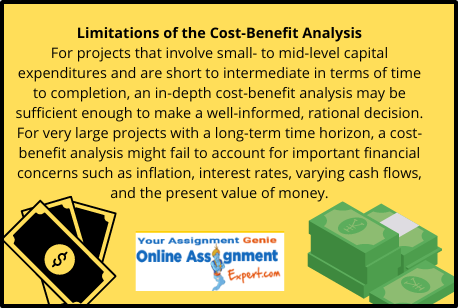
As a student of economics and learning business modules, you must make sound financial decisions in your assignments to prove yourself a capable businessman in the coming future. While learning business objectives, you have to consider variants such as the following:
Do you doubt that a particular choice is best for your company? Do you wonder whether investing the time and money necessary to succeed in a suggested project will be worthwhile? Despite the possibility that it will affect your entire company, are you thinking about changing your business, marketing, or sales strategy?
Business analytics—more particularly, performing a cost-benefit analysis—is how many enterprises, organizations, and entrepreneurs respond to these and other questions. At Economics assignment help, our professional experts explain the cost-benefit analysis and provide exemplary solutions to your financial queries. You can get academic guidance under our university assignment help services.
According to Smith (2014), comparing the anticipated or predicted costs and benefits (or opportunities) connected with a project choice to assess whether it makes sense from a business standpoint is known as a cost-benefit analysis. Cost-benefit analysis generally entails totalling the expenses associated with a project or decision, deducting that sum from the predicted benefits, and calculating the net result. (This value is sometimes shown as a ratio.)
You could claim that the choice is wise if the anticipated advantages outweigh the costs. On the other hand, a business may want to reconsider the choice or initiative if the costs surpass the advantages. Before making important organizational decisions, conducting this analysis has major financial advantages. Analyses allow you to separate important data, such as your company's value chain or the ROI of a project.
Cost-benefit analysis is the type of data-driven decision-making most frequently used in business, both at established organizations and startups. Whether a decision is made for business purposes or not, it can be made using the basic ideas and framework. For a clear mode of understanding cost-benefit analysis, you can contact our university assignment help experts.
You must first set the framework for your analysis in order for it to be as precise as feasible. The characteristics of your company will determine how this framework appears. Describe the aims and purposes you hope to achieve with the proposal. What must you achieve for the project to be deemed successful? This will be crucial in evaluating the findings of your investigation and can help you identify and comprehend your expenses and advantages.
Similarly, choose the statistic you'll use to quantify and contrast the advantages and disadvantages. Your costs and benefits should be calculated using the same "common currency" to compare the two appropriately. It doesn't necessarily include using money, but it typically involves giving each prospective cost and benefit a monetary value.
The next thing you should do is sit down and create two distinct lists, one of all the anticipated costs and the other of all the anticipated advantages of the proposed project or course of action. You'll probably start by adding up the direct costs, which are directly associated with creating or developing a good or service (or implementing a project or business decision). Examples of direct expenses include labour, manufacturing, materials, and inventory costs.
However, it's also crucial to be outside the conventional. There are a few other expenses you should consider:
Indirect costs are often fixed costs associated with running a firm, such as rent and utilities.
Intangible costs: Any present and future expenses that are challenging to identify and assess are considered intangible costs. Examples can be lower productivity levels after implementing a new company process or lower customer satisfaction following modifications to customer care procedures that result in fewer repeat purchases.
Opportunity cost: Opportunity costs are the benefits or opportunities that are missed when a company chooses one course of action over another.
After those specific charges have been determined, it is similarly crucial to comprehend any potential advantages of the suggested course of action or undertaking. Among those advantages are:
Direct: More money and sales brought in by a new product
Indirect: Increased consumer interest in your company or brand
Intangible: increased staff morale
Competitive: being a pioneer in a particular sector or business
The correct monetary units must be established by giving each expense and benefit a dollar figure once you have created detailed listings of all prices and advantages. It will be challenging to compare costs and benefits accurately if you don't assign a value to each, but even if the problem persists, assignment help is available for this task.
Direct expenses and gains will be the ones that are the simplest to put a price on. However, estimating secondary and intangible benefits and costs cannot be easy. Although numerous software choices and approaches are available for determining these less evident numbers, that does not imply you shouldn't try.
You may compare the two lists once each expense and benefit has a dollar value next to it. There is a business case for you to move forward with the project or decision if the total benefits outweigh the total expenses. If overall expenditures are greater than overall benefits, you might want to reevaluate your plan.
You should refer back to the framework created in step one in addition to just comparing the overall costs and advantages. Have you achieved the objectives you've selected as success indicators, or does the analysis indicate that you haven't?
If the benefits outweigh the costs, investigate whether there are any other options you haven't thought of. Additionally, you might be able to find savings that will help you accomplish your objectives more inexpensively while still being successful.
An individual or organization can examine a choice or potential project without prejudice by using cost-benefit analysis. As a result, it provides an unbiased and fact-based examination of your options, which can assist in making your company more analytical and data-driven.
Business decisions are, by their very nature, difficult. The cost-benefit analysis helps simplify this difficulty by reducing a decision to costs against benefits.
By making you list every conceivable cost and benefit connected to a project, the cost-benefit analysis can reveal less-obvious aspects like indirect or intangible expenses.

Therefore, using this terminology and study in commercial studies is extremely helpful. For further academic assistance, the ideal service is provided by economics assignment help, where several economics professionals are ready to provide the best guidance and support.
Get
500 Words Free
on your assignment today